Lithuania, the small Baltic state bordering Russian ally Belarus to the east and Russia’s Kaliningrad exclave to the west, only declared its independence in 1990.
Dating back as far as the 18th century, there has been a significant number of ethnic Russians in Lithuania; Russian remains the country’s largest minority language. Immigration between the two states increased during the Soviet occupation, and there are still to this day 48 ‘Russian schools’ in the country, teaching about 14,000 students each year.
It is no surprise, then, that just days after the invasion of Ukraine in February 2022, Lithuania announced a state of emergency.
Independence is not something Lithuania takes for granted. Baltic history is one of occupation. Lithuania was linked with Poland for more than 200 years from the 16th century, before the Russian empire exerted its control, and later the German military. In fact, 1918 was the first time Lithuania and its Baltic sisters had their own truly autonomous governments, lasting only until 1940 when all three were swallowed up by the USSR.
And yet, Lithuania remains both a unique ethnic and cultural region with a rich heritage and folklore. Over the past 30 years, to protect some of this distinction, officials have turned to an unlikely strategy – encouraging the creation of national parks.
 Lake Plateliai is the central attractions of Zemaitjia National Park | Photo: Alamy
Lake Plateliai is the central attractions of Zemaitjia National Park | Photo: Alamy
A member of the European Union since 2004, Lithuania has five national parks whose inauguration in the 1990s belies their long history. The Baltic state had just one national park before declaring independence from the USSR. The following year, local authorities designated a further three parks before adding a fifth in 1992.
In fact, 12 of the 15 national parks across the Baltic states were inaugurated after the collapse of the Soviet Union. These reclamations of nature have been seen as a vital part of the post-Soviet identity building process – an act of defiance and of determination.
Although spearheaded by local officials, the national park movement in Lithuania can be seen as a response to a public appetite for conservation and access to nature, explains Rovena Augustinė, head of the visitor service department at the Žemaitija National Park Directorate.
“Lithuania is a green country with stunning forests, lakes, rivers, meadows and landscapes. Therefore, it is naturally understood that Lithuanian residents appreciate and respect what they have and support all organisations involved in nature conservation,” she explains.
No park illustrates this better than Žemaitija national park, established in 1991 across more than 20,000 hectares with the dual purpose of protecting the region’s unique biodiversity and cultural heritage – including the local dialect.
Žemaitija – also known as Samogitia – is a vast region in north-west Lithuania famous for its rural beauty and thriving flora and fauna. Telšiai, its regional capital, is a popular stopover for travellers making the further 20km journey into Žemaitija national park, a land of lakes, dense wetlands and deep forests. An impressive 45 per cent of the park is covered in trees.
 Dzukija National Park | Photo: Alamy
Dzukija National Park | Photo: Alamy
While it does not have the Unesco World Heritage status of its sister national park on the Curonian Spit, or Dzūkija’s abundance of large mammals including wild wolves, elk and boar, Žemaitija is unique because it is an ethnic region home to a rooted and resolute indigenous population. Zemaitija national park isn’t just a sanctuary to endangered plant and animal species. It is a home to families who have lived in the same villages for centuries.
Samogitians speak an ancient Baltic dialect believed to have been inherited from the last pagans of Europe who made the region their final, bloody stand. This strong local ethnic identity is the main driver of the region’s dormant but longstanding independence movement, as well as its rich seam of folklore including the famous story that the first Samogitians were a trio of children lost in the forest but saved and raised by a mother bear.
A retreating glacier left 26 lakes across the park’s undulating terrain. On a still day, birch, pine and spruce trees reflect in the water with haunting clarity. With around 19 sq kilometres of lakes and ponds, almost 10 per cent of the park is water, with a further 15 per cent wetland.
Lake Plateliai is the largest of these with a 24km circumference. Despite being a popular stopover for locals holidaying by the Baltic sea, the lake’s eponymous town retains a quiet atmosphere.
Plateliai has extensive footpaths and cycling trails which give meaning and structure to the otherwise formidable terrain. The flora here is rich and diverse with more than 1,250 different plant species (70 of which are considered endangered in Lithuania), including everything from the protected fen orchid to the extremely rare Botrychium simplex, a small fern otherwise thought to be extinct in Europe.
Lithuanian residents appreciate what they have, and support organisations involved in nature conservation
Twitchers will find a number of hides around the park, nestled between bogs and mounds, and beside beds of high-rising reeds. Local conservationists have successfully worked to preserve Samogitia’s bird habitats – for the first time in decades, white-tailed eagles were spotted in recent years.
Climate change has been a major driver of habitat loss across Lithuania’s national parks. But in Žemaitija, farming has been equally responsible. More than one-fifth of the park is now used for agriculture. This tension between conservation, privatisation and farming has plagued wildlife conservation across the world.
“The park’s administration has a responsibility to protect nature. Our staff are constantly collecting data about protected wildlife and bird species,” Augustinė explains. “And where it is necessary, we take action on everything from grass cutting to hydrological restoration.”
Conservationists across Lithuania are also working to prevent biodiversity loss. For example, Dzukija national park, in southern Lithuania, near the borders with Poland and Belarus, has been accommodating endangered bison for more than 10 years, and in March this year completed work on a new sanctuary, protecting the mammal that has lost much of its territory in central Lithuania due to farming.
“The park, as a territory, is very important for promoting tourism in the north-western part of Lithuania. It is a major part of the region’s tourism strategy,” says Augustinė.
 Zemaitija National Park | Photo: Alamy
Zemaitija National Park | Photo: Alamy
But there is also a darker side to the park’s serene landscape, one that nods to the country’s not-so distant Soviet past. A couple of kilometres east of Lake Plateliai sits the Soviet-era Plotškinė missile base, which once housed four R-12 Dvina missiles with thermonuclear warheads, weighing 40 tonnes and with a range of around 2,000km. These underground silos have been restored with uncanny accuracy; deep black holes – where soil should be – measure more than 22m deep and almost 2m wide. Opened as a cold war museum in 2012, the mycelium of subterranean passageways also feature eerily lifelike mannequins.
Lithuania’s national parks are testament to its distinct culture. When the parks were inaugurated, Vytautas Landsbergis was Lithuania’s ‘president’ and the first of the post-Soviet era. In June this year he gave a stark warning at a ceremony in his home country: “Russia has become a cancer of Europe,” he said. “If it is cured, the world may survive, but if not, it may lead to the destruction of the world.”
Lithuania is a young state, if anything has validated its credentials as a contemporary European nation, it is the way it has embraced national parks as monuments to its past and its future.
Sign up to The Parliament's weekly newsletter
Every Friday our editorial team goes behind the headlines to offer insight and analysis on the key stories driving the EU agenda. Subscribe for free here.